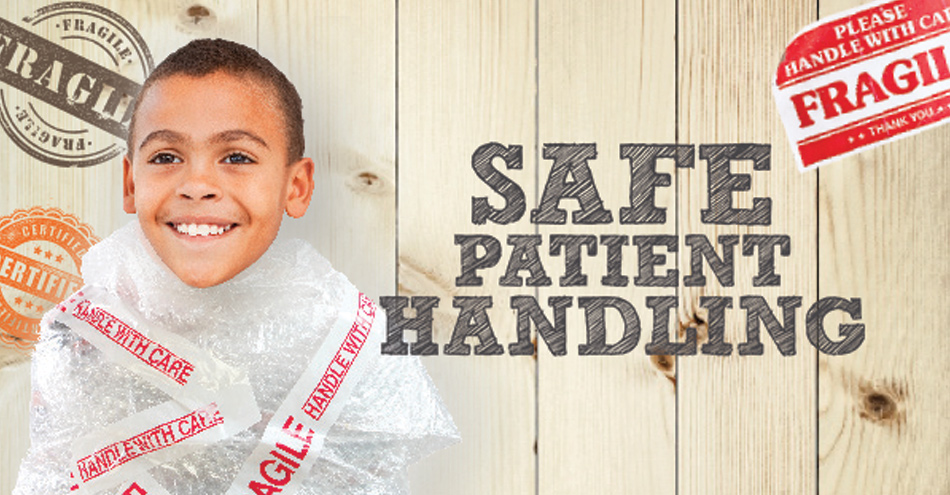Cover Story: Safe Patient Handling
By: Don Sadler
It’s one of the most dangerous and highest risk activities that occurs in the OR that almost nobody talks about: safe patient handling and mobility, or SPHM.
The practices of transporting, lifting, positioning and holding patients in the OR are fraught with danger for patients and OR personnel alike. In fact, musculoskeletal disorders (MSDs) represent one of the leading causes of occupational injury and disability in healthcare.
The High Cost of MSDs
According to OSHA, sprains and strains are the most often reported nature of healthcare worker injuries, and the shoulders and lower back are the most affected body parts. The Bureau of Labor Statistics (BLS) notes that 12 percent of nurses leave the profession every year as the result of a MSD.
Meanwhile, the average MSD claim costs $11,771, while the average cost of a back injury is $37,000, according to the BLS.
 “The unsafe manual lifting and moving of patients has been identified as a key cause of musculoskeletal injuries among healthcare teams,” says Dee Kumpar, MBA, BSN, RN, CSPHP, the Director Safe Patient Handling Programs and Services and a Clinical Marketing Consultant with Hill-Rom. “Unsafe manual handling tasks such as lateral transfers, limb holding and positioning patients in prone position are everyday occurrences in the OR.”
“The unsafe manual lifting and moving of patients has been identified as a key cause of musculoskeletal injuries among healthcare teams,” says Dee Kumpar, MBA, BSN, RN, CSPHP, the Director Safe Patient Handling Programs and Services and a Clinical Marketing Consultant with Hill-Rom. “Unsafe manual handling tasks such as lateral transfers, limb holding and positioning patients in prone position are everyday occurrences in the OR.”
“For the OR nurse, MSD injuries are a direct result of overexertion, which includes motions such as lifting, bending, reaching or slipping without falling,” adds Patty Taylor, vice president, Professional Education and Clinical Affairs with Ansell. “The consequences of unsafe patient handling have led to a wide range of different types of nurse injuries, as well as a negative impact on the quality of patient care.”
The handling and movement of patients in the OR presents a number of challenges due to the patient’s level of consciousness, physical disabilities, cognitive understanding, size and medical condition.
“Compounding this unfavorable situation is that patients are lifted by OR nurses by reaching over the patient bed or stretcher and the OR table, which places heavy loads on the spine,” says Taylor.
Cumulative Repetitive Effects
The repetitive nature of patient handling tasks in the OR, combined with unsafe patient handling techniques and the failure to use SPHM techniques and technology, are what put OR nurses at such high risk of MSD injuries, says Mary J. Ogg, MSN, RN, CNOR, a Perioperative Nursing Specialist with AORN.
Ogg says she once oversaw a staff of 50 perioperative personnel and five of them — or 10 percent — had back, shoulder or neck injuries.
“More than half of all AORN members are over the age of 52, so the cumulative effect of unsafe patient handling practices over many years can be very damaging on OR nurses,” Ogg says.
The National Institute for Occupational Safety and Health (NIOSH) has recommended that healthcare workers should not manually lift more than 35 pounds of a patient’s body weight themselves. If more than this weight must be lifted, NIOSH recommends that assistive lifting devices and technologies like air-assisted lateral transfer devices, new technology transfer boards, friction reducing sheet and ceiling lifts be used.
It might surprise you to learn that one leg accounts for approximately 16 percent of a patient’s total body weight. So a 250-pound patient’s leg can weigh 40 pounds, thus exceeding the NIOSH recommendation for safe manual lifting.
“In this situation, at least two perioperative team members should raise or hold the leg in position, or a mechanical device should be used to help,” says Ogg.
“Most OR suites do not use safe patient handling devices and technologies,” notes Ronda Fritz, RN, BSN, MA, a Safe Patient Handling Facility Champion at VA Nebraska-Western Iowa Health Care Systems in Omaha, Neb. “Ceiling lifts are the gold standard for patient lifting and handling in the OR, but there are only two ORs in the country that I’m aware of that use ceiling lifts.”
“I have risk assessed many ORs and most have not adopted safe patient handling techniques,” adds Heather M. Monaghan MHSc, RN, the president and CEO of Visioning HealthCare Inc. in Sarasota, Fla. “Unfortunately, many nurses just accept the fact that their back will hurt and they’ll just take a couple of pain pills.
“But this shouldn’t be acceptable,” Monaghan says. “We need to do things differently.”
Monaghan points out that the OR is just the midpoint in a surgical patient’s journey through the hospital. She says she counted the number of times she was physically transferred when she had knee surgery recently.
“I was transferred four times, not including onto the OR table because I was able to move myself across to it,” says Monaghan. “So there are many opportunities for hospital staff to injure themselves and potentially increase risk to patients during the transfer process.”
Of course, obese patients present special challenges when it comes to safe patient handling techniques.
“Obesity presents a unique challenge, as it increases the risk of lifting, moving and repositioning injuries to both patients and OR nurses,” says Taylor.
Obese and morbidly obese patients require specialized equipment in the OR to accommodate their body size, Taylor adds.
“The OR table may need to have extensions, attachments, longer restraining straps and padding added. And sufficient manpower will be required to care for the obese patient — additional OR staff will need to help with positioning and removal of the patient from the OR table.”
Steps That Are Being Taken
The good news when it comes to safe patient handling is that there seems to be an increased level of attention being paid to the problem at several different levels.
“Organizations, especially OSHA and The Joint Commission, have taken great strides in establishing regulations and protocol to make the healthcare work environment ergonomically safe,” says Taylor.
“Many states are now passing ‘no-lift’ laws to protect nurses from injuries resulting from unsafe patient handling and lifting,” Taylor adds. “These new laws require healthcare facilities to establish safe patient handling committees, programs, practices and zero-lift policies.”
In addition, AORN has created a Safe Patient Handling and Movement Guidance Statement and Safe Patient Handling Toolkit, which AORN members can download for free at www.aorn.org. And the American Nurses Association (ANA) has published the Safe Patient Handling and Mobility Interprofessional National Standards, which can be purchased at www.nursesbooks.org.
“Hospitals are implementing products, policies and procedures to reduce the number of slips, trips and falls that occur each year,” says Taylor. “And safe patient handling committees have been formed and ergonomic specialists have been put on staff at many hospitals. Also, the National Association of Orthopaedic Nurses (NAON) and the ANA have adopted patient handling guidelines.”
Fritz believes that one of the keys to reducing MSD injuries among OR nurses and improving patient safety when it comes to patient handling is getting hospitals to implement the right SPHM devices and technologies.
“Manual patient handling should be eliminated to the highest degree possible,” she says.
“However, most surgeons don’t like change, and time is always a factor in the OR,” Fritz adds. “The best solution is to design new ORs with the latest safe patient handling technology and devices, because retrofitting existing ORs can be difficult and costly.”
“Safe patient handling and mobility is an issue that should be addressed by every hospital OR today,” says Ogg. “The negative consequences of unsafe patient handling practices on OR nurses and patients are just too costly — in both financial and, more importantly, nurse and patient safety terms.”












